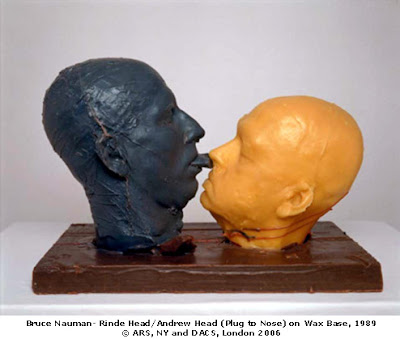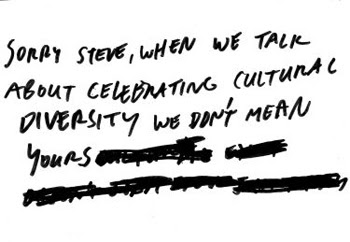Painter Charline von Heyl recently described American’s disconnect between the personal and the political this way: “While almost everything in the outer world feels messed-up, our inner lives aren’t altogether messed-up.” The current art world, awash in money and success, is shot through with a similar disconnect. To some, the art market is a self-help movement, a private consumer vortex of dreams, a cash-addled image-addicted drug that makes consumers prowl art capitals for the next paradigm shift. This set seeks out art that looks like things it already knows: anything resembling Warhol, Richter, Koons, Tuymans, Prince and Wool could be good; any male painter in his 30s could be great. To others, the market is just a happy popularity contest, or as New York Times reporter David Carr put it about having his own blog, it’s like “a large yellow Labrador: friendly, fun, not all that bright, but constantly demanding your attention.”
For many, the art market is a communal version of the Primal Scene — a sexed-up site that offers a peek into the bedroom of the creative act. Art advisors and collectors now treat art fairs and auctions like Warhol’s Factory: Places to flaunt junkielike behavior while hoping one’s creative potential might bloom. In this global circus, mega-collectors like Charles Saatchi and François Pinault are the art world’s P.T. Barnums: showmen who have become part of the show — moguls who understand that the market is a medium that can be manipulated. Once upon a time, the market and the scene (clubiness, chicanery and profligacy notwithstanding) were joined and reflected social, political and sexual change. Now the market is only in service of itself. The market is a perfect storm of hocus-pocus, spin and speculation, a combination slave market, trading floor, disco, theater and brothel where an insular ever-growing caste enacts structured rituals in which the codes of consumption and peerage are manipulated in plain sight.
Consider the lame-brained claim made by Sotheby ’s Worldwide Head of Contemporary Art, Tobias Meyer, who recently effused, “The best art is the most expensive because the market is so smart.” This is exactly wrong. The market isn’t “smart;” it’s like a camera — so dumb it’ll believe anything you put in front of it. Essentially, the art market is a self-replicating organism that when it tracks one artist’s work selling well craves more work by the same artist. Although everyone says the market is “about quality,” the market merely assigns values, fetishizes desire, charts hits, and creates ambience. These days the market is also too good to be true. Still, the slap-happy assertions keep coming. Last season, Amy Cappellazzo, International Head of Christie’s Post- War and Contemporary Art, crowed that auction houses were “the big-box retailers putting the mom-and-pops out of business.” Then she gushed of her clients, “After you have a fourth home and a G5 jet, what else is there?” After wondering, “What’s a G5 jet?” you may well ask how the current super-heated art market is changing the ways we see and think about art. These days no one knows. The market is now so pervasive that it is simply a condition — as much a part of the art world as galleries and museums. Even if you’re not making money — as is the case with most of us — that’s your relationship to the market. To say you won’t participate in the market is like saying you refuse to breathe the air because it’s polluted. The current market feeds the bullshit machine, provides a lot of cover for a lot of vacuous behavior, revs us up while wearing us down, breeds complacency, and is so invasive that it forces artists to regularly consider issues of celebrity, status and money in their studios. Yet, it also allows more artists to make more money without having to work full-time soul-crushing jobs — and it provides most of us with what Mel Brooks called “our phony-baloney jobs.” Last December more than 400 New York art dealers representing more than 5,000 artists paid for booths in one art fair or another in Miami to participate in this market. Everyone is trying the best they can. For critics to demonize the entire art world as somehow unethical or crass is selfrighteous, cynical and hypocritical.
Much confusion stems from there being no new cogent Theory of the Market, no philosophy that addresses he ways in which the ongoing feeding frenzy is affecting the production, presentation and reception of art. Nothing we say about the market adds-up, partly because “the market” isn’t really an autonomous subject. It’s a diversionary tactic. Essentially, it’s a blend of economics, history, psychology, stagecraft and ifestyle, an unregulated field of commerce governed by desire, luck, stupidity, cupidity, personal connections, connoisseurship, intelligence, insecurity and whatever. Yet we can’t ignore the market or just sit back and drink the Kool Aid. Maybe we should be asking questions such as: Are we sometimes liking things because we know the market likes them or are we really liking them? Do people really believe the icky kitschy pictures of naked girls with pussy cats by German painter Martin Eder are any good or are buyers simply jumping on the bandwagon because his prices have reached $500,000? When we learn that a newish painting by the second-rate latterday fuzzy Neo-Expressionist Marlene Dumas sold for over three million dollars, does it alter how we think of her work? Does it alter the ways magazine editors or curators think about it? The curator of Dumas’ upcoming Museum of Modern Art exhibition, the otherwise excellent Connie Butler, recently responded to one of my public hissy-fits about the overestimation of this artist by saying, “Dumas has been making portraits of terrorists,” as if to suggest that certain subject matter exempts art from criticism. In fact, this subject matter is not only predictable and generic, and in that sense utterly conservative, it’s perfect fodder for a culture in disconnect. It’s wonderful that mediocre women artists
like Dumas now command the same astronomical prices for their art that mediocre male artists always have. But do artists who don’t sell for high prices have less of a chance to ever make money? Are Vito Acconci and Adrian Piper fated to forever being “Lifestyles of the Poor and Famous” artists? If you’re unknown and over 35 do you have a shot? In this era of the 30-month career, what happened to the 30-year career? Will there one day be a Larry Gagosian Gallery in every major art capital?
In the 1970s, conceptualist Joseph Kosuth said, “The only people who care about art are artists.” That’s obviously changed. The art world is big business. Vanity Fair and W have launched annual “Art Issues;” we have “Power lists” and “Top Ten” issues galore. In January three young male art stars canoodled together in bed in their underpants on the cover of New York Magazine. Inside the magazine we read about their rising prices and that one of them is “well-endowed.” That’s fine, although the all-white-maleness of many of these things is only more proof of the unexamined agenda-driven blindness of the art market. But, is the art world of greater interest to people outside it because art has become more interesting or because art is a hot property? Is the market creating a competitive atmosphere that drives artists to produce better work or is it mainly fostering empty product?
If there’s a silver lining to this golden cloud it’s that despite how professional and “smart” it is made out to be, the market is still inherently blinkered, erratic and insecure. As such it is simultaneously vulnerable and a force of chaos. As almost everyone in the art world knows, chaos is almost always good for art. In addition, the disconnect between our public and personal lives is so unstable that it too is a site of chaos, albeit an internal one that could be exploited. Finally, at the end of the day art still has a private inside and a public outside. It still exudes an alchemical otherness. In our studios and before artworks we still experience moments of authentic serenity, passion and meaningfulness — places on the edge of language that the market can’t strip away. In this imperfect realm we can intuit the elemental feeling that sometimes, just by making or looking at art, we might glimpse the full range of human possibilities. The market is art minus otherness. “The rest,” as artist Anat Elberg recently wrote, “is gossip.”
Jerry Saltz is the Senior Art Critic for the Village Voice. He is a two-time finalist for the Pulitzer Prize in Criticism. The Good, The Bad and The Very Bad is a new Flash Art column by Jerry Saltz.








